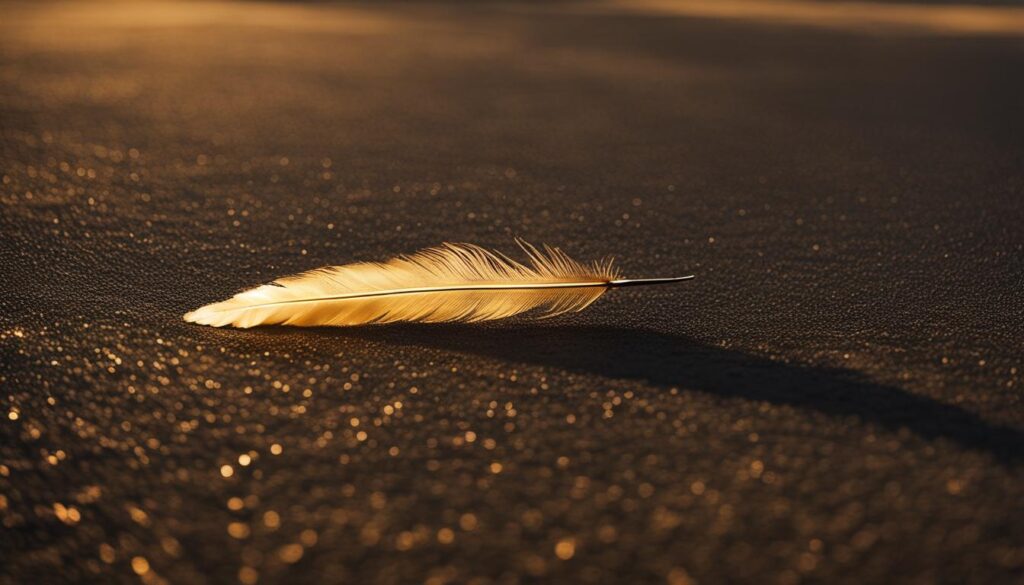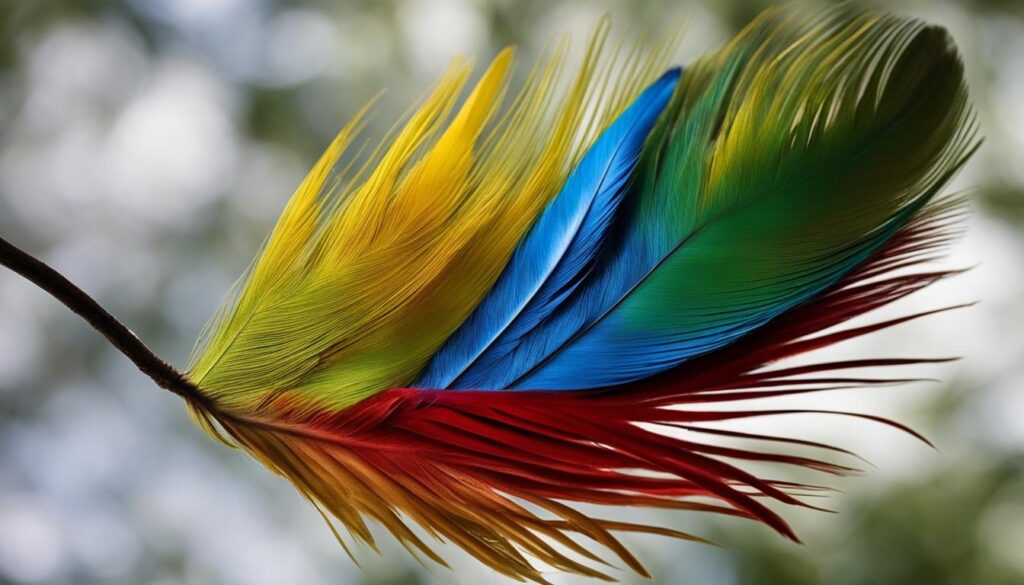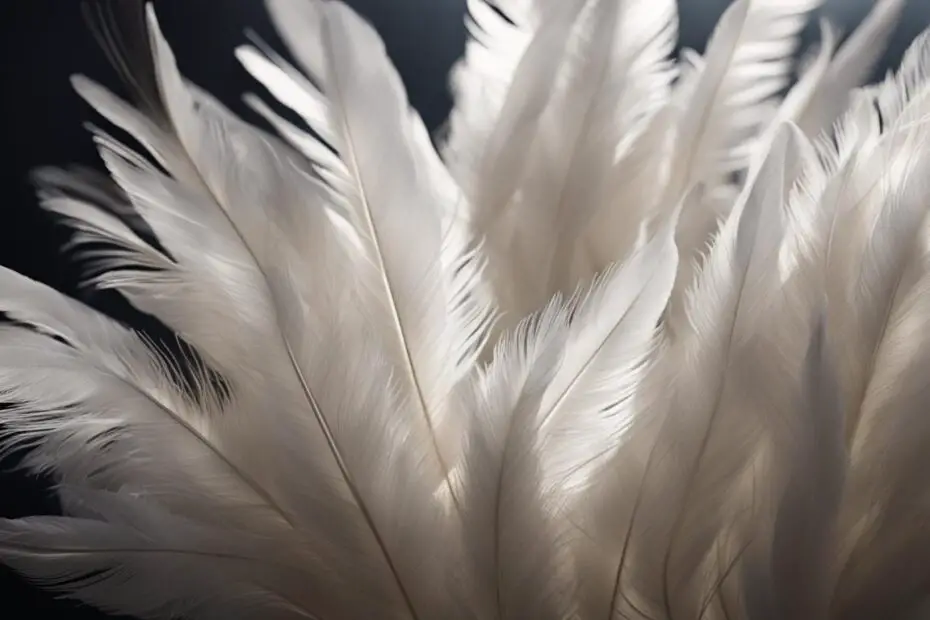In various spiritual traditions, prayer feathers hold deep cultural and symbolic significance. These feathers are used as powerful tools for prayer, connecting humans with the divine and carrying messages between the two realms. Prayer feathers are a testament to the enduring importance of spiritual practices and sacred rituals in our modern world.
These feathers symbolize love, representing a profound connection with the Creator. When used in prayer, they serve as a reminder of the power of intentional communication and the transformative nature of spiritual connection. The significance of prayer feathers can be seen in healing practices, cultural traditions, and the wider spiritual community.
Prayer feathers can be made from various materials and are used in different ways depending on the specific tradition. Their usage has evolved over time, adapting to changing cultural and societal contexts, while still remaining an integral part of many spiritual practices.
Key Takeaways:
- Prayer feathers have deep spiritual significance in various cultures
- They symbolize love, connection with the Creator, and the power of prayer
- Prayer feathers are used in healing practices, cultural traditions, and sacred rituals
- They can be made from a variety of materials and have evolved over time
- Prayer feathers serve as important tools for intentional communication and spiritual connection
The Meaning and Symbolism of Prayer Feathers
Prayer feathers hold profound symbolism in native cultures. They are seen as a connection with the Creator and represent the flow of love. These feathers remind individuals to love unconditionally, even when faced with challenges or unmet expectations. They are believed to carry prayers to the divine when tied onto a bush and let the wind carry them. In some traditions, prayer feathers are also used during smudging ceremonies to cleanse spaces and uplift prayers. The use of prayer feathers serves as a reminder of the power of love and the importance of spiritual connection.
Prayer feathers serve as important tools in various spiritual practices. They can be held close to the heart or between the hands as individuals focus on their prayers. Some traditions involve tying the feathers onto a bush to allow the wind to carry the prayers to the Creator. In smudging ceremonies, prayer feathers are used to waft sacred smoke and cleanse the space. The act of using prayer feathers during these practices helps individuals connect with the divine, express their intentions, and seek spiritual guidance.
Prayer feathers symbolize love, connection with the Creator, and the power of prayer.
The symbolism of prayer feathers varies among different sects and cultures. Indigenous communities have their unique traditions and practices when it comes to prayer feathers. Each sect may have specific rituals, prayers, and ways of tying or using the feathers. It is important to respect and honor the cultural variations in the use of prayer feathers and to understand the specific significance they hold within each community’s spiritual traditions.
| Symbolism | Meaning |
|---|---|
| Connection with the Creator | Prayer feathers are seen as a means to connect with the divine and the spiritual realm. |
| Flow of Love | They remind individuals to love unconditionally and serve as a symbol of the power of love. |
| Carrier of Prayers | Prayer feathers are believed to carry prayers to the divine when tied onto a bush and let the wind carry them. |
| Cleansing and Uplifting | Prayer feathers are used in smudging ceremonies to cleanse spaces and uplift prayers. |
Prayer feathers continue to hold deep meaning and significance in spiritual practices. They serve as powerful symbols of love, connection with the Creator, and the power of prayer.
The Use of Prayer Feathers in Practice
Prayer feathers serve as important tools in various spiritual practices. They are used in different ways to facilitate connection with the divine and express intentions. Individuals may hold prayer feathers close to their heart or between their hands as they focus on their prayers. This physical contact with the feathers serves as a reminder of the sacredness of the prayer and helps to deepen spiritual connection.
One common practice involving prayer feathers is tying them onto a bush or tree, allowing the wind to carry the prayers to the Creator. This act symbolizes the release of one’s intentions and the trust in the divine to receive and answer those prayers. It is a way to surrender control and place faith in the power of prayer.
In smudging ceremonies, prayer feathers are used to waft sacred smoke and cleanse the space. The feathers are gently waved through the smoke, spreading its purifying energy throughout the room or area. The act of using prayer feathers during smudging ceremonies not only physically clears negative energy but also represents the invitation of spiritual guidance and blessings into the space.
The use of prayer feathers is deeply rooted in spiritual beliefs and practices, emphasizing the importance of intention, connection, and gratitude. Whether held, tied, or used during rituals, these feathers serve as a bridge between the physical and spiritual realms, aiding in the communication between individuals and the divine.

The Role of Prayer Feathers in Smudging Ceremonies
Within various spiritual traditions, smudging ceremonies are conducted as a way to purify spaces, objects, and individuals. Prayer feathers play a significant role in these ceremonies, enhancing the spiritual essence and power of the smudging process.
During a smudging ceremony, herbs such as sage, cedar, or sweetgrass are burned, and the smoke is believed to carry prayers, intentions, and blessings. As the smoke moves through the air, the feathers are used to gently guide and disperse it, ensuring that it reaches every corner of the space or person being smudged. The feathers create a flow and connection between the spiritual and physical realms, amplifying the energy and potency of the ceremony.
Prayer feathers used in smudging ceremonies are often chosen with intention. Some traditions prefer to use large feathers for their ability to carry more smoke, while others may select specific types of feathers based on their sacred or symbolic significance. The feathers are regarded as sacred tools, bringing blessings, purification, and spiritual protection to the ceremony and those involved.
Prayer Feathers as Vessels for Intention
Prayer feathers serve as vessels for intention, acting as conduits between the earthly and spiritual dimensions. By holding or using prayer feathers during prayer or ritual, individuals infuse their intentions and desires into the feathers, believing that they will be carried to the divine.
The act of physically holding the feathers allows individuals to focus their energy and attention on their prayers. The softness and delicate nature of the feathers provide a tactile and visual reminder of the sacredness of the moment. As the feathers are touched, individuals may feel a sense of connection and presence, deepening their spiritual experience.
Prayer feathers are also used as focal points for visualization and manifestation. As individuals hold the feathers, they imagine their prayers being transformed into physical reality. This visualization process strengthens the intention and belief that their prayers will be heard and answered.
| Prayer Feather Ritual | Symbolism |
|---|---|
| Tying feathers onto a bush or tree | Release of intentions, trust in the divine |
| Using feathers in smudging ceremonies | Purification, spiritual guidance, blessings |
| Holding feathers during prayer | Focusing intention, deepening spiritual connection |
Variations in Prayer Feathers Among Sects
Prayer feathers, although holding deep spiritual significance, can vary in their usage and symbolism among different sects and cultures. Indigenous communities, in particular, have their unique traditions and practices when it comes to prayer feathers. Each sect may have specific rituals, prayers, and ways of tying or using the feathers. It is essential to respect and honor the cultural variations in the use of prayer feathers and to understand the specific significance they hold within each community’s spiritual traditions.
In Native American cultures, for example, the specific design and arrangement of the feathers can differ based on the tribe and individual beliefs. Some may tie the feathers together with a sacred thread, while others may weave them into intricate patterns. The number and type of feathers used may also vary, with certain tribes placing a particular emphasis on the feathers of specific birds, such as eagles or hawks. These variations highlight the diversity and richness of indigenous spiritual practices.
| Sect | Rituals | Feather Arrangement | Symbolism |
|---|---|---|---|
| Navajo | Blessings, prayers, and healing ceremonies | Feathers tied together with colorful yarn | Connection with the divine; protection from evil |
| Maori | Gifts, blessings, and ancestral worship | Single feather adorned with intricate carvings | Communication with ancestors; spiritual guidance |
| Hopi | Kachina ceremonies and rain dances | Feathers woven into elaborate designs | Harmony with nature; fertility and abundance |
Understanding the cultural variations in the use of prayer feathers allows for a deeper appreciation of the diverse spiritual practices within indigenous traditions. It also highlights the importance of preserving and respecting these sacred rituals and symbols, ensuring their continued relevance and significance for future generations.
Materials Used for Prayer Feathers
Prayer feathers, as important spiritual tools, are crafted using a variety of materials based on cultural traditions and resource availability. The choice of materials contributes to the symbolism and aesthetic of the prayer feathers. The most commonly used material is bird feathers, particularly those from sacred birds like eagles or hawks, which hold special significance in many indigenous cultures. These feathers are revered for their association with spiritual connection and divine communication. Other bird feathers, such as those from wild turkeys, are also utilized in the creation of prayer feathers.
In addition to feathers, prayer feathers may be adorned with various decorations that enhance their spiritual meaning. These decorative elements often include beads, leather, or other symbolic items that hold cultural significance within specific traditions. The use of beads can represent prayers, intentions, or ancestral connections, while leather may signify protection or grounding. The choice of materials and decorations for prayer feathers reflects the rich indigenous artistry and traditional craftsmanship that has been passed down through generations.
Table: Materials Used for Prayer Feathers
| Feather Materials | Symbolism |
|---|---|
| Bird Feathers (Eagles, Hawks, Turkeys) | Connection with the divine, spiritual communication |
| Beads | Representation of prayers, intentions, ancestral connections |
| Leather | Symbol of protection, grounding |
| Other symbolic elements | Materials that hold specific cultural significance within various traditions |
The selection of materials for prayer feathers is a meaningful process that aligns with the spiritual and cultural beliefs of the community. By utilizing feathers from sacred birds and incorporating additional symbolic elements, prayer feathers become powerful conduits for prayer, connection, and spiritual guidance.
Evolution of Prayer Feathers Over Time
Prayer feathers have a rich history that has evolved over time, adapting to changing cultural and societal contexts. The significance of prayer feathers remains constant, symbolizing love, connection with the divine, and the power of prayer. However, the materials used and specific rituals associated with prayer feathers have undergone modifications.
The evolution of prayer feathers can be attributed to various factors, such as colonization, globalization, and the blending of spiritual practices. As different cultures interacted and exchanged ideas, the use of prayer feathers became influenced by external influences.
For example, some indigenous communities had to adapt their materials due to limited access to sacred birds’ feathers, which were traditionally used. This led to the use of feathers from other birds, such as wild turkeys, or the use of synthetic feathers that closely resemble natural ones. Additionally, the ways prayer feathers are incorporated into spiritual practices may have changed, taking on new forms or variations.
| Aspect | Historical Changes |
|---|---|
| Materials | Evolved due to limited access to traditional sacred feathers, leading to the use of feathers from other birds or synthetic materials. |
| Rituals | Modified and adapted to reflect changing cultural and societal contexts, influenced by colonization, globalization, and the blending of spiritual practices. |
| Symbolic Meanings | Have remained consistent, representing love, connection with the divine, and the power of prayer, despite changes in materials and rituals. |
“The evolution of prayer feathers showcases the resilience and adaptability of spiritual practices. While the core symbolism and purpose remain intact, prayer feathers have embraced change and continue to be meaningful in contemporary contexts.”
Prayer feathers are not static artifacts; they embody the dynamic nature of culture and spirituality. The ability of prayer feathers to evolve over time is a testament to the enduring importance of spiritual connection and the need to adapt to changing circumstances while maintaining the essence of tradition.
Lesser-Known Prayer Tools
While prayer feathers are well-known prayer tools, there are also lesser-known prayer objects that hold spiritual significance in different cultures. These unique tools serve various purposes and contribute to the rich tapestry of spiritual practices found worldwide.
Dreamcatchers
 One such tool is the dreamcatcher, which originated in Native American cultures. Dreamcatchers are believed to filter out negative dreams and allow only positive ones to pass through. They consist of a hoop adorned with a web-like pattern and are often decorated with feathers, beads, and other symbolic elements. Dreamcatchers are hung above beds or in sacred spaces to provide protection and bring peaceful, healing dreams.
One such tool is the dreamcatcher, which originated in Native American cultures. Dreamcatchers are believed to filter out negative dreams and allow only positive ones to pass through. They consist of a hoop adorned with a web-like pattern and are often decorated with feathers, beads, and other symbolic elements. Dreamcatchers are hung above beds or in sacred spaces to provide protection and bring peaceful, healing dreams.
Prayer Sticks
Another lesser-known tool is the prayer stick, used by Southwestern Native American tribes. These beautifully crafted objects are adorned with feathers and other offerings. Prayer sticks are used to connect with ancestors and express gratitude. They are often planted in the ground as a physical representation of prayers, serving as a reminder of the interconnectedness of all beings.
These lesser-known prayer tools, like prayer feathers, hold deep spiritual meaning and play a role in guiding individuals on their path of spiritual growth and connection.
Feathers as Signs and Messages
Finding a feather, particularly in unexpected places, is often seen as a sign or message from the spiritual realm. Feathers are believed to be messages from angels or departed loved ones, indicating their presence and offering comfort and support. The interpretation of feather signs may vary from person to person, as they are highly personal experiences. Some individuals believe that feathers are validation of intuitions or guidance, while others see them as reminders to focus on specific issues or questions they have been pondering.
Feathers are seen as symbolic messages that can provide insight and reassurance in times of need. They serve as a reminder that we are not alone and that there are spiritual forces guiding and supporting us. The presence of a feather can bring comfort, hope, and a sense of connection to something greater than ourselves.

“Feathers are messages from angels, I truly believe that. Whenever I find a feather, I feel like my guardian angel is watching over me.” – Sarah
The Different Meanings of Feather Signs
Feathers can come in various colors and sizes, each carrying its own unique symbolism and meaning. Here are some common interpretations:
- White Feathers: White feathers are often associated with purity, innocence, and divine presence. They are a gentle reminder that angels are watching over us and offering their support and guidance.
- Gray Feathers: Gray feathers signify neutrality and can represent peace, balance, and tranquility. They may be a sign to trust the process and find equilibrium in challenging situations.
- Brown Feathers: Brown feathers symbolize stability, grounding, and practicality. They can serve as a reminder to stay rooted and focused on the present moment.
- Black Feathers: Black feathers can carry a mysterious and protective energy. They may indicate that it’s time to release negative emotions or fears and embrace transformation and personal growth.
| Feather Color | Symbolic Meaning |
|---|---|
| White | Purity, innocence, divine presence |
| Gray | Peace, balance, tranquility |
| Brown | Stability, grounding, practicality |
| Black | Mystery, protection, transformation |
The interpretation of feather signs is subjective and should be based on personal intuition and connection with the divine. Each individual’s experience with feathers as signs and messages is unique and deeply personal. Regardless of the specific interpretation, finding a feather can serve as a powerful reminder of the spiritual support and guidance available to us.
Feather Symbolism in Various Cultures
Feathers hold deep symbolic meanings in diverse cultures throughout history. From Native American traditions to Ancient Egypt and even references in the Bible, feathers have been revered as powerful symbols of spiritual significance.
In Native American cultures, feathers are seen as a connection to the divine. They are often used in sacred ceremonies and represent a spiritual link between humans and the Creator. Feathers are used as prayer tools to carry messages and intentions to the spiritual realm.
In Ancient Egypt, feathers symbolized truth, justice, and order. The goddess Ma’at, who represented truth and balance, was often depicted with a feather on her head. Feathers were seen as a symbol of the divine’s guidance in maintaining harmonious relationships and upholding moral principles.
The Bible also references feathers as a symbol of protection and God’s care. In Psalm 91:4, it is written, “He will cover you with his feathers, and under his wings, you will find refuge.” This verse conveys the belief that feathers represent divine shelter and comfort in times of difficulty.
The cultural interpretations of feather symbolism may vary, but the recurring themes of transcendence, freedom, and communication with spiritual realms remain consistent. Feathers continue to hold a special place in the hearts and minds of individuals seeking spiritual connection and guidance.
Feather Color Meanings
Feathers come in a variety of colors, each carrying its own symbolic meanings and associations. Understanding the significance of these colors can provide deeper insight into the messages and symbolism conveyed through feathers.
White Feather
A white feather is often seen as a powerful symbol of purity, spiritual connection, and divine presence. It is commonly associated with angels and is believed to be a sign of comfort, protection, and guidance from the spiritual realm.
Pink Feather
A pink feather symbolizes unconditional love, compassion, and tenderness. It serves as a gentle reminder to practice love and kindness towards oneself and others. Pink feathers can offer comfort and support during challenging times, encouraging individuals to approach life with an open heart.
Red Feather
Red feathers represent vitality, passion, strength, and courage. They symbolize the fire within, driving individuals to pursue their dreams and overcome obstacles fearlessly. Red feathers remind us to embrace our power and live life with determination, energy, and enthusiasm.
Orange Feather
Orange feathers carry the energy of creativity, emotional balance, and intuition. They inspire individuals to explore their artistic abilities, embrace their emotions, and trust their instincts. Orange feathers symbolize the warmth of the sun and the joy that comes from expressing oneself authentically.
Yellow Feather
Yellow feathers symbolize happiness, optimism, and self-confidence. They bring a sense of joy and positivity, encouraging individuals to embrace a sunny outlook on life. Yellow feathers can uplift spirits, inspire optimism, and serve as a reminder to approach challenges with a positive mindset.
Green Feather
Green feathers represent growth, renewal, prosperity, and abundance. They symbolize the natural world, reminding individuals of the importance of nurturing their physical and spiritual well-being. Green feathers encourage personal growth, healing, and a harmonious connection with nature.

The symbolic meanings associated with feather colors can vary slightly across different cultures and belief systems. However, these general interpretations provide a foundation for understanding the messages and symbolism conveyed through feathers. Whether you come across a white feather, a pink feather, a red feather, an orange feather, a yellow feather, or a green feather, take a moment to reflect on the potential messages and guidance they may hold for you.
Feather Symbolism in the Movie Forrest Gump
The critically acclaimed movie Forrest Gump, directed by Robert Zemeckis, masterfully utilizes the symbolism of feathers to explore profound themes of destiny, fate, and personal choice. Throughout the film, the feather is depicted as a metaphor for life’s unpredictable nature and the power of individual agency.
In the opening scene of the movie, a white feather gracefully floats down from the sky, gently landing at the feet of Forrest Gump, the central character portrayed by Tom Hanks. This feather serves as a visual representation of the film’s overarching message that life’s direction is often guided by external circumstances beyond our control.
“I don’t know if we each have a destiny, or if we’re all just floating around accidental-like on a breeze, but I think maybe it’s both.”
As Forrest Gump embarks on his extraordinary journey, the feather becomes a recurring motif, appearing at pivotal moments. It symbolizes the power of personal choice amidst the unpredictability of life. Despite facing numerous hardships and challenges, Forrest’s unwavering optimism and resilience allow him to make the best of whatever life presents him.
The feather in Forrest Gump ultimately underscores the film’s central theme that while destiny and fate may play a role in shaping our lives, our choices and actions are what truly define us. It serves as a powerful reminder that even in the face of adversity, we have the ability to shape our own destinies and find meaning and purpose amidst life’s uncertainties.

Table: Key Themes of Feather Symbolism in Forrest Gump
| Themes | Description and Symbolism |
|---|---|
| Destiny and Fate | The feather represents the notion that life’s direction is often beyond our control, guided by forces we cannot fully comprehend. |
| Personal Choice | Despite the unpredictability of life, the feather serves as a reminder that we have the power to make choices that shape our own destinies. |
| Resilience and Optimism | Forrest Gump’s unwavering positivity and resilience in the face of adversity are symbolized by the feather, highlighting the transformative power of a positive mindset. |
| Meaning and Purpose | The feather represents the search for meaning and purpose in life, reminding us to find value in every experience and embrace the opportunities that come our way. |
Conclusion
Prayer feathers hold significant cultural and spiritual significance in various traditions. They are powerful prayer tools that symbolize love, connection with the divine, and the power of prayer. These feathers serve as reminders of the importance of spiritual connection, gratitude, and intention in our lives. Whether used in Native American ceremonies or other spiritual practices, prayer feathers hold a deep cultural significance that transcends borders and belief systems.
The symbolism of prayer feathers is deeply personal and can vary among individuals. Each person’s interpretation and connection with these tools may differ, but the cultural value and symbolism of prayer feathers remain strong. They act as a bridge between the spiritual and physical realms, providing a means for individuals to express their deepest intentions and seek spiritual guidance.
While prayer feathers are commonly associated with Native American traditions, it’s important to recognize that variations exist among different sects and cultures. Each community has its unique rituals, prayers, and ways of using these tools. It is crucial to respect and honor these cultural variations, understanding the specific significance they hold within each community’s spiritual traditions.
As with any cultural practice, prayer feathers have evolved over time, adapting to changing societal contexts. They have been influenced by factors such as colonization, globalization, and the blending of spiritual practices. Despite these changes, prayer feathers continue to be meaningful in contemporary contexts, reminding us of the power of love, connection, and personal interpretation in our spiritual journeys.
FAQ
What is the significance of prayer feathers in various cultures?
Prayer feathers have deep spiritual significance and are used as tools for prayer. They are believed to carry messages between humans and the divine, symbolizing love, connection with the Creator, and the power of prayer.
How are prayer feathers used in spiritual practices?
Prayer feathers can be held close to the heart or between the hands during prayer. They can also be tied onto a bush to let the wind carry the prayers to the Creator. In smudging ceremonies, prayer feathers are used to waft sacred smoke and cleanse the space.
Do different cultures have variations in the use of prayer feathers?
Yes, different cultures and sects may have specific rituals, prayers, and ways of tying or using prayer feathers. It is important to respect and honor the cultural variations in the use of prayer feathers within each community’s spiritual traditions.
What materials are used to make prayer feathers?
Prayer feathers can be made from various materials, including bird feathers, such as those from sacred or revered birds like eagles or hawks. Feathers from other birds, such as wild turkeys, can also be used. Prayer feathers may also be decorated with beads, leather, or other symbolic elements.
How have prayer feathers evolved over time?
The use of prayer feathers has been influenced by factors like colonization and globalization, leading to changes in the materials used and specific rituals associated with them. However, the core symbolism and purpose of prayer feathers remain unchanged.
Are there other prayer tools besides prayer feathers?
Yes, there are other prayer tools that hold spiritual significance, such as prayer sticks and dreamcatchers. These tools have their unique symbolism and purpose in different cultures and spiritual practices.
What do feathers symbolize in different cultures?
Feathers symbolize connection to the divine in Native American cultures, truth and justice in Ancient Egypt, and protection and God’s care in the Bible. The cultural interpretations of feather symbolism may vary, but they consistently represent transcendence, freedom, and communication with spiritual realms.
What do different feather colors mean?
White feathers represent comfort, support, and divine presence. Pink feathers symbolize unconditional love. Red feathers represent vitality and courage. Orange feathers signify creativity and intuition. Yellow feathers represent happiness and self-confidence. Green feathers symbolize prosperity and renewal.
What is the significance of feathers in the movie Forrest Gump?
The white feather in the movie represents life’s unpredictability and the power of personal choice. It serves as a metaphor for resilience, adaptability, and the potential for growth and transformation.
What is the conclusion regarding prayer feathers?
Prayer feathers hold significant cultural and spiritual significance, symbolizing love, connection with the divine, and the power of prayer. Their interpretation and personal significance may vary, but their cultural value and symbolism remain strong.








